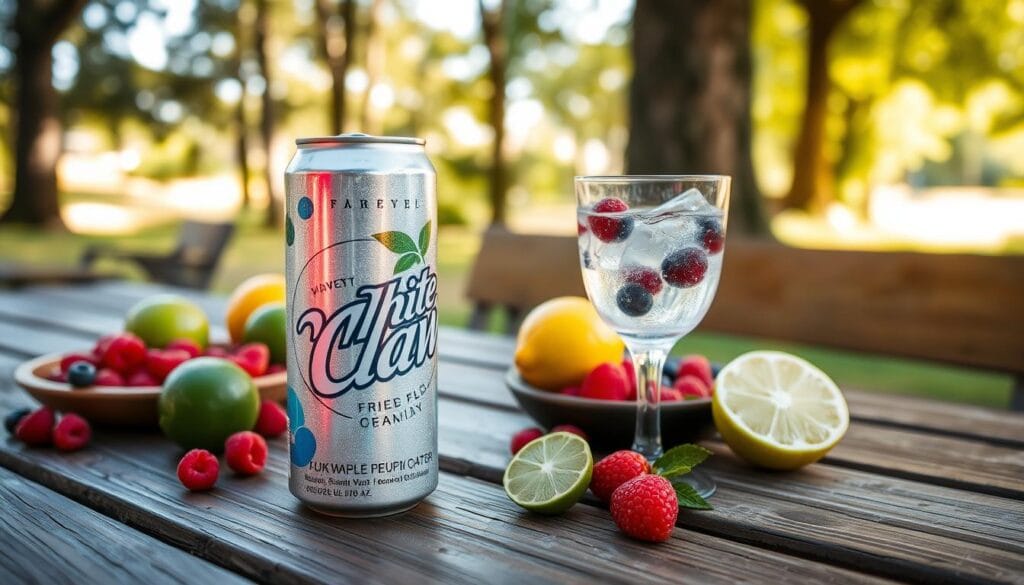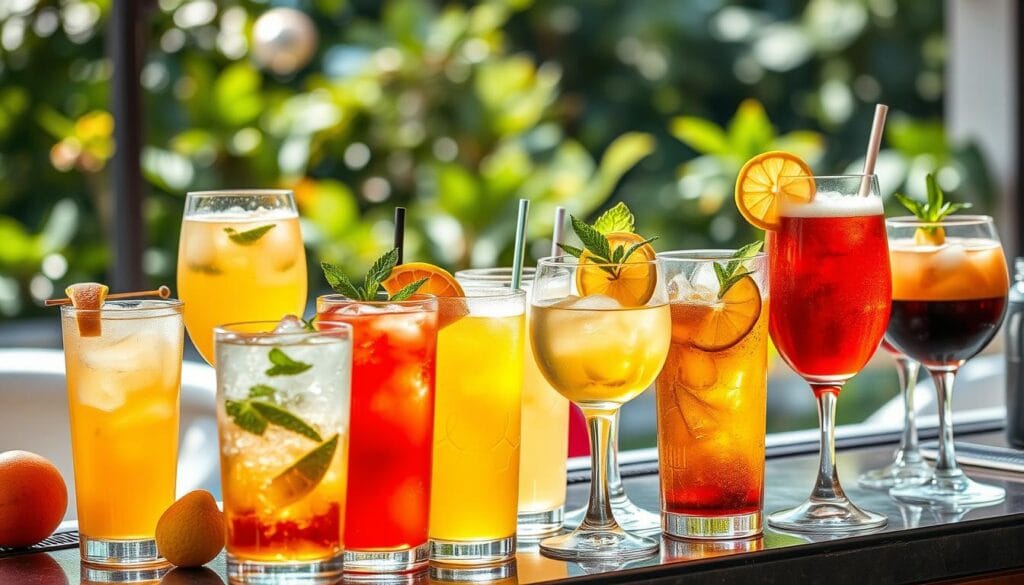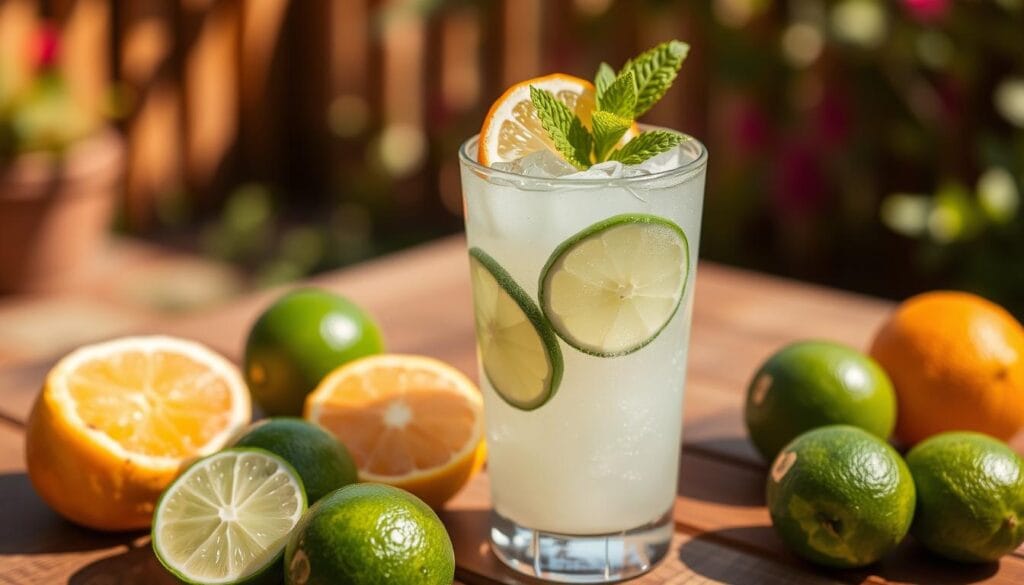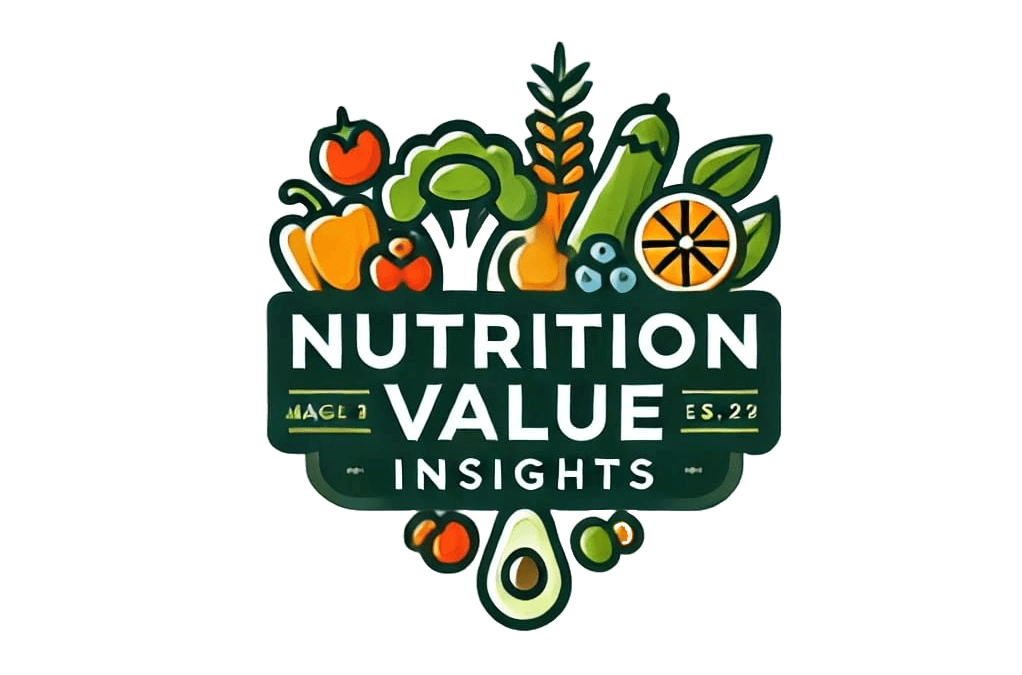White Claw Nutrition Facts: Calories, Carbs, and Ingredients Explained
White Claw has become a top choice in the hard seltzer market. It’s known for its tasty flavors and unique brewing method. This guide will look into White Claw’s nutrition facts, including calories, carbs, and ingredients.

Table of Contents
Understanding What Makes White Claw Different
The rise of gluten-free hard seltzer drinks has changed the alcohol world. White Claw leads this trend. It’s known for its special brewing and gluten-free alcohol base, appealing to health-focused drinkers.
The Rise of Hard Seltzers
Hard seltzers have become very popular. They offer a low-calorie, gluten-free choice compared to beer and spirits. These drinks are perfect for those who want a refreshing, guilt-free drink.
White Claw’s Unique Brewing Process
White Claw stands out with its unique brewing method. It starts with seltzer water and a gluten-free alcohol base. Then, it adds natural fruit flavors. This makes a clean, crisp drink that many enjoy.
The Gluten-Free Alcohol Base
White Claw is known for its gluten-free alcohol base. This makes it safe for those with gluten sensitivities or dietary needs. Its gluten-free nature makes it appealing to a health-conscious market.
“White Claw’s unique brewing process and gluten-free alcohol base have set it apart as a leading player in the hard seltzer market, catering to the growing demand for healthier and more inclusive alcoholic beverage options.”
White Claw Nutrition Facts: Basic Breakdown
A standard 12 oz. can of White Claw has just 100 calories. It has only 1g of carbohydrates. There is no protein or fat, making it a low-calorie choice.
The sugar content in white claw is low. Most flavors use natural juice concentrates and a bit of cane sugar for sweetness. This is different from many other drinks that are high in sugar.
| Nutrient | Amount per 12 oz. Can |
|---|---|
| Calories | 100 |
| Carbohydrates | 1g |
| Protein | 0g |
| Fat | 0g |
| Sugar | Minimal (from natural juice concentrates and cane sugar) |
The white claw nutrition facts show it’s a healthier choice for alcohol lovers. It’s good for those watching their calorie and carb intake. But, remember, drinking in moderation is important for a healthy lifestyle.
Caloric Content Across Different Sizes
Understanding white claw 12 oz nutrition facts is key. The calories in White Claw match the can size. Whether it’s a 12 oz, 16 oz, 19.2 oz, or 24 oz can, the white claw low-calorie drink stays consistent.
12 oz Can Nutrition
A 12 oz White Claw can has 100 calories. It’s a guilt-free choice for a refreshing drink.
16 oz Can Comparison
The 16 oz White Claw can has 130 calories. It’s still a white claw low-calorie drink.
19.2 oz and 24 oz Options
For bigger servings, White Claw has 19.2 oz and 24 oz cans. They have about 160 and 200 calories, respectively. These sizes offer a more indulgent experience but stay true to the white claw low-calorie drink promise.
| Can Size | Calories |
|---|---|
| 12 oz | 100 |
| 16 oz | 130 |
| 19.2 oz | 160 |
| 24 oz | 200 |
No matter the size, White Claw is a white claw low-calorie drink. It’s a favorite among those who care about their health.
Carbohydrate and Sugar Content Analysis
White Claw is a low-carb choice for those watching their carbs. Each 12 oz can has only 1g of carbs. This makes it great for low-carb or keto diets. The sugar in White Claw comes from a bit of cane sugar and natural fruit juice.
White Claw has less carbs and sugar than many drinks. For example, a regular beer has about 5g of carbs. A 5 oz glass of wine has 3.8g of carbs. Even light beers have 3.2-5g of carbs per serving.
| Beverage | Carbs (per 12 oz/360 mL) | Sugar (per 12 oz/360 mL) |
|---|---|---|
| White Claw | 1g | Minimal (from cane sugar and fruit juice concentrates) |
| Regular Beer | Around 5g | Varies |
| Light Beer | 3.2-5g | Varies |
| Wine (5 oz/150 mL) | 3.8g | Varies |
For those watching carbs or sugar, White Claw is a good choice. It has very little carbs and sugar. But remember, no drink, including White Claw, is truly healthy. It can lead to dehydration and too much drinking.

Complete Ingredients List and Natural Flavoring
White Claw is proud of its simple and natural ingredients. Each flavor has a few main parts: purified carbonated water, alcohol, natural flavors, cane sugar, citric acid, and sodium citrate.
Base Ingredients Explained
The purified carbonated water makes White Claw fizzy. The alcohol, from 4.5% to 5% ABV, is gluten-free. The natural flavors, like cherry or mango, are the main attraction.
Natural Juice Concentrates
- Black Cherry
- Mango
- Ruby Grapefruit
- Raspberry
- Natural Lime
- Watermelon
- Tangerine
- Lemon
- Strawberry
- Blackberry
- Pineapple
Artificial vs. Natural Sweeteners
White Claw uses cane sugar instead of artificial sweeteners. This natural sweetener balances the tartness and gives a clean taste.
Using the same ingredients in all flavors shows White Claw’s dedication. They aim to offer a consistent, quality hard seltzer experience.
Popular Flavor Varieties and Their Nutritional Differences
White Claw offers a wide range of flavors to please everyone. From citrus to tropical fruits, each flavor has its own nutritional profile. Let’s explore some of the most loved White Claw flavors and their nutritional differences.
Flavors like Black Cherry, Mango, Ruby Grapefruit, and Raspberry have about 100 calories per 12-ounce serving. They also have a 5% alcohol by volume (ABV). This makes White Claw a better choice than many beers and mixed drinks, which can have 150 to 500 calories.
For a citrus kick, try Natural Lime, Lemon, and Tangerine. They have the same calories and alcohol as the other flavors. This keeps the nutritional profile consistent across White Claw.
If you love fruity tastes, check out Watermelon, Strawberry, Blackberry, and Pineapple. Each flavor offers a unique taste while keeping nutritional values the same.
When comparing hard seltzers, White Claw stands out. Its simple ingredients include carbonated water, alcohol, natural flavors, and citric acid. This is different from some brands that use artificial sweeteners or heavy mixers.
| Flavor | Calories (12 oz) | Carbs (12 oz) | Alcohol (ABV) |
|---|---|---|---|
| Black Cherry | 100 | 2g | 5% |
| Mango | 100 | 2g | 5% |
| Ruby Grapefruit | 100 | 2g | 5% |
| Raspberry | 100 | 2g | 5% |
| Natural Lime | 100 | 2g | 5% |
| Watermelon | 100 | 2g | 5% |
| Tangerine | 100 | 2g | 5% |
| Lemon | 100 | 2g | 5% |
| Strawberry | 100 | 2g | 5% |
| Blackberry | 100 | 2g | 5% |
| Pineapple | 100 | 2g | 5% |
In summary, White Claw’s wide range of flavors offers a consistent nutritional profile. This makes it a top choice for those looking for a low-calorie, refreshing drink. Whether you like citrus, tropical, or berry flavors, White Claw has something for everyone.
Comparing White Claw to Other Alcoholic Beverages
White Claw has fewer calories and carbs than beer and wine. It’s a hard seltzer with a lighter nutritional profile. This makes it a good choice for those watching their health.
Beer vs. White Claw
A 12-ounce can of beer has 153 calories. In contrast, a 12-ounce can of White Claw has only 100 calories. White Claw is also gluten-free, unlike most beers. Both have about 5% alcohol by volume (ABV).
Wine vs. White Claw
A 5-ounce glass of red wine has 125 calories, a bit more than White Claw. Wine has more alcohol, about 12% ABV, than White Claw’s 5% ABV.
Mixed Drinks vs. White Claw
Mixed drinks can have different calorie and carb counts. A drink with 80-proof liquor and a zero-calorie mixer has about 96 calories. But, cocktails with added sugars, like a Mai Tai, can have up to 61 calories per ounce.
White Claw and other hard seltzers are a lower-calorie, lower-carb option. They’re popular for those who want a refreshing, guilt-free drink.
| Beverage | Calories per Serving | Alcohol Content (ABV) |
|---|---|---|
| White Claw (12 oz can) | 100 calories | 5% |
| Beer (12 oz can) | 153 calories | 5% |
| Red Wine (5 oz glass) | 125 calories | 12% |
| Liquor with Zero-Calorie Mixer (1.5 oz shot) | 96 calories | 40% (80 proof) |
| Cocktail (Mai Tai) | 61 calories per ounce | Varies |
The data shows that white claw vs beer nutrition and comparing hard seltzers to traditional drinks. It shows low-carb alcoholic drinks like White Claw are a healthier choice for a refreshing drink.
“Hard seltzer contains around 5 percent alcohol, while the average glass of wine contains about 12 percent alcohol. Beer has more calories than hard seltzer, making it a heavier beverage to consume.”
Health Considerations and Dietary Restrictions
When we talk about is white claw healthy, the answer is mostly yes. White Claw is a gluten-free hard seltzer that’s low in calories. It’s made with simple ingredients and doesn’t have added sugars. This makes it a good choice for many people.
One big plus of drinking white claw is that it’s gluten-free. This is great for people with gluten sensitivities or celiac disease. They often have to watch what they drink. White Claw also has few calories and carbs, which is good for those watching their diet.
| Beverage | Calories | Carbs | Gluten-free |
|---|---|---|---|
| White Claw | 100 calories per 12 oz can | 2 grams per 12 oz can | Yes |
| Beer | Varies, typically 150-200 calories per 12 oz | Varies, typically 12-20 grams per 12 oz | Some varieties are gluten-free |
| Wine | Varies, typically 120-150 calories per 5 oz | Varies, typically 3-5 grams per 5 oz | Yes, most wines are gluten-free |
| Cocktails | Varies, can be high in calories depending on mixers | Varies, can be high in sugar depending on mixers | Depends on the base spirit |
But, it’s important to drink White Claw responsibly. It has alcohol, which can affect your health. Drinking in moderation is always the best choice.

In summary, White Claw is a better choice for those with dietary needs or who want to make healthier choices. It’s gluten-free and low in calories and carbs. But, remember it’s still alcohol and should be enjoyed in moderation.
Making Informed Choices: Reading White Claw Labels
Understanding the nutrition facts on White Claw labels is key to making smart choices about alcohol. White Claw, a popular hard seltzer brand, gives detailed info on its products. This helps consumers make better choices.
The labels on White Claw cans show serving size, calories, carbs, sugars, and alcohol by volume (ABV). By looking at these labels, you can know what’s in your White Claw. This lets you pick what fits your diet and taste.
A standard 12-ounce can of White Claw has 100 calories, 2 grams of carbs, and 5% ABV. This info helps you compare it to other drinks like beer or wine. It helps you pick the best drink for your health goals.
White Claw also has many flavors, each with different nutrition. Reading labels shows the small differences in calories, sugars, and ingredients. This lets you choose the flavor that’s right for you.
By understanding White Claw labels, you can make smart choices about drinking. This ensures your drink fits your health and wellness goals. Remember, drinking responsibly is important for enjoying White Claw and other drinks in a balanced way.
- White Claw nutrition labels include details on serving size, calories, carbohydrates, sugars, and alcohol content.
- Comparing nutrition facts across different White Claw flavors and other alcoholic beverages can help you make informed choices.
- Carefully reading labels can reveal subtle differences in the nutritional profiles of various White Claw varieties.
- Understanding White Claw nutrition facts empowers you to consume the brand’s beverages in a responsible and health-conscious manner.
“Consuming alcohol in moderation and being mindful of the nutritional content is key to maintaining a balanced lifestyle.”
Conclusion
White Claw is a lower-calorie, low-carb choice compared to many drinks. It’s gluten-free and has natural flavors. This might attract those looking for white claw nutrition facts and low-carb alcoholic drinks. But, remember, drinking White Claw or any alcohol should be done in moderation.
White Claw might seem like a healthier option. Yet, it’s key to think about how alcohol affects your body and fitness goals. It can slow down muscle recovery, change hormone levels, and lead to weight gain if not drunk in small amounts.
Choosing to drink White Claw or other alcohol should be a thoughtful decision. Knowing the potential downsides and drinking responsibly is important. By being informed and making smart choices, you can enjoy White Claw and other drinks while keeping your health in check.
FAQ
What is White Claw made of?
White Claw Hard Seltzer is a mix of seltzer water, gluten-free alcohol, and fruit flavor. It includes purified carbonated water, alcohol, and natural flavors. It also has cane sugar, citric acid, natural juice concentrates, and sodium citrate.
How many calories are in White Claw?
A 12 oz. can of White Claw has 100 calories.
How many carbs are in White Claw?
A 12 oz. can of White Claw has 1g of carbs.
Is White Claw gluten-free?
Yes, White Claw uses a gluten-free alcohol base. This makes it safe for those with gluten sensitivities or celiac disease.
What are the health benefits of drinking White Claw?
White Claw has fewer calories and carbs than many drinks. This might attract health-conscious drinkers. But, it’s still alcohol and should be enjoyed responsibly.
Does White Claw have any artificial sweeteners?
No, White Claw uses natural sweeteners like cane sugar and fruit juice concentrates. It doesn’t have artificial sweeteners.
What are the different flavors of White Claw?
White Claw comes in many flavors. You can find Black Cherry, Mango, Ruby Grapefruit, Raspberry, and Natural Lime. There’s also Watermelon, Tangerine, Lemon, Strawberry, Blackberry, and Pineapple.
How does the calorie and carb content of White Claw compare to other alcoholic beverages?
White Claw has fewer calories and carbs than beer, wine, and mixed drinks. Its gluten-free nature also makes it different from most beers.
Where can I find the nutrition information for White Claw?
White Claw provides detailed nutrition labels for all its products. You can find info on serving size, calories, carbs, sugars, and alcohol content.
DID OUR INFORMATION HELP YOU ?
There are no reviews yet. Be the first one to write one.

